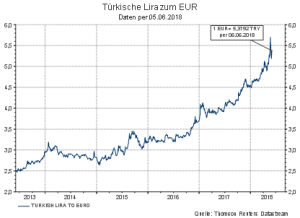Turkish assets underwent a strong correction in May. The Turkish lira had intermittently lost more than 11% relative to the euro, while the yield of the 5Y local currency bond increased by almost 200bps to 15.3%, and the interest rate differential (spread) between Turkish government bonds and US dollar-denominated government bonds widened by 72bps to 390bps (N.B. 100bps = 1 percentage point). The Turkish central bank was forced to raise its most important interest rate by 300bps and to re-align its monetary instruments. What are the reasons for this nosedive?
Central bank is not acting independently
New statements made by President Erdogan according to which he wanted to take over the monetary policy in the event of an election victory set off a loud alert among investors. Erdogan has often expressed his opinion in the past according to which rising interest rates were causing rising prices and has thus exerted pressure on the central bank to refrain from hiking rates.
However, the imbalances in the Turkish economy have become so noticeable in the meantime that the continuation of the unorthodox and hesitant monetary policy of recent years would make a hard landing of the Turkish economy increasingly likely. For example, economic growth amounted to 7.4% last year, while inflation had soared to 12%. This means that inflation is twice as high as the inflation target set by the central bank. The current account deficit last year accounted for more than 6% of GDP. The current account deficit pushes up debt and thus the dependence of the country on external lenders.
Significant external vulnerability
At USD 182bn falling due in the coming twelve months, the external gross financing need of Turkey is very high. In addition, the country has to deal with a current account deficit of about USD 55bn and a foreign exchange imbalance in the corporate sector of USD 222bn. This is juxtaposed by a mere USD 34bn worth of foreign exchange reserves. This means that the foreign exchange liabilities of Turkey are a long shot away from full coverage by the central bank’s own reserves. While these imbalances per se are nothing new and the financing regime of the deficits has been stable to date, they do push Turkey into a rather exposed situation, given the rising US interest rates.
Turkish lira vs. euro (06/2013-06/2018)

Source: Thomson Reuters Datastream; data as of per 6 June 2018
Currency depreciation affects asset quality of banks
Increasing worries over a very hard landing have moved the focus onto the asset quality among banks. Rising interest rates, i.e. an additional cost factor, and the increasing interest and redemption outlay for companies with outstanding foreign exchange loans and a lack of forex revenues should cause the number of non-performing loans to rise. At the moment, however, the share of non-performing loans is at a very low 2.8% in terms of total loans outstanding. Also, the Turkish banking sector is very well capitalised and thus thoroughly shielded against any credit defaults.
Uncertainty prior to snap elections
At the end of April, President Erdogan announced parliamentary and presidential elections for June, to the surprise of some market participants. As a result of this election, Turkey will switch to a presidential system, which means that the president will be holding more power. Whereas the confirmation of Recep Tayyip Erdogan’s presidency seems likely, polls suggest that the opposition might secure a majority in parliament, which could make the future decision-making process significantly more complex. For the case of an all-around AKP majority, on the other hand, investors are concerned that this would mean further drifting towards economic and financial instability.
Fiscal policy turning pro-cyclical
With government debt of 28% in terms of GDP, Turkey is in relatively good shape when compared to countries with similar ratings. At the moment, Turkey holds a Ba2 rating from Moody’s, which puts the country into the high-yield segment. The new debt of only 1.5% in terms of GDP also illustrates the budgetary discipline and supports the rating of Turkey. The announcement of a fiscal stimulus package worth USD 6bn in a period of economic overheating as election sweetener has led some market participants to question the continuation of this unorthodox fiscal policy and to reduce positions in Turkish assets.
Outlook: the most recent steps taken by the central bank, i.e. an interest rate hike and the simplification of the monetary policy, can be interpreted as sign that all the political decision-makers have wised up to the seriousness of the situation. This means that the monetary policy might switch to an orthodox regime in the wake of the elections. For example, steps towards reducing the current account deficit and the inflation rate have been announced for the time after the elections. In addition, the good shape the public finances are in provides the Turkish state with some room to manoeuvre in the event of the worsening of the status quo. In our base case scenario, we therefore expect the Turkish currency and bond markets to calm.
Legal notice: forecasts are no reliable indicator for future developments.
Legal disclaimer
This document is an advertisement. Unless indicated otherwise, source: Erste Asset Management GmbH. The language of communication of the sales offices is German and the languages of communication of the Management Company also include English.
The prospectus for UCITS funds (including any amendments) is prepared and published in accordance with the provisions of the InvFG 2011 as amended. Information for Investors pursuant to § 21 AIFMG is prepared for the alternative investment funds (AIF) administered by Erste Asset Management GmbH pursuant to the provisions of the AIFMG in conjunction with the InvFG 2011.
The currently valid versions of the prospectus, the Information for Investors pursuant to § 21 AIFMG, and the key information document can be found on the website www.erste-am.com under “Mandatory publications” and can be obtained free of charge by interested investors at the offices of the Management Company and at the offices of the depositary bank. The exact date of the most recent publication of the prospectus, the languages in which the fund prospectus or the Information for Investors pursuant to Art 21 AIFMG and the key information document are available, and any other locations where the documents can be obtained are indicated on the website www.erste-am.com. A summary of the investor rights is available in German and English on the website www.erste-am.com/investor-rights and can also be obtained from the Management Company.
The Management Company can decide to suspend the provisions it has taken for the sale of unit certificates in other countries in accordance with the regulatory requirements.
Note: You are about to purchase a product that may be difficult to understand. We recommend that you read the indicated fund documents before making an investment decision. In addition to the locations listed above, you can obtain these documents free of charge at the offices of the referring Sparkassen bank and the offices of Erste Bank der oesterreichischen Sparkassen AG. You can also access these documents electronically at www.erste-am.com.
Our analyses and conclusions are general in nature and do not take into account the individual characteristics of our investors in terms of earnings, taxation, experience and knowledge, investment objective, financial position, capacity for loss, and risk tolerance. Past performance is not a reliable indicator of the future performance of a fund.
Please note: Investments in securities entail risks in addition to the opportunities presented here. The value of units and their earnings can rise and fall. Changes in exchange rates can also have a positive or negative effect on the value of an investment. For this reason, you may receive less than your originally invested amount when you redeem your units. Persons who are interested in purchasing units in investment funds are advised to read the current fund prospectus(es) and the Information for Investors pursuant to § 21 AIFMG, especially the risk notices they contain, before making an investment decision. If the fund currency is different than the investor’s home currency, changes in the relevant exchange rate can positively or negatively influence the value of the investment and the amount of the costs associated with the fund in the home currency.
We are not permitted to directly or indirectly offer, sell, transfer, or deliver this financial product to natural or legal persons whose place of residence or domicile is located in a country where this is legally prohibited. In this case, we may not provide any product information, either.
Please consult the corresponding information in the fund prospectus and the Information for Investors pursuant to § 21 AIFMG for restrictions on the sale of the fund to American or Russian citizens.
It is expressly noted that this communication does not provide any investment recommendations, but only expresses our current market assessment. Thus, this communication is not a substitute for investment advice.
This document does not represent a sales activity of the Management Company and therefore may not be construed as an offer for the purchase or sale of financial or investment instruments.
Erste Asset Management GmbH is affiliated with the Erste Bank and austrian Sparkassen banks.
Please also read the “Information about us and our securities services” published by your bank.



